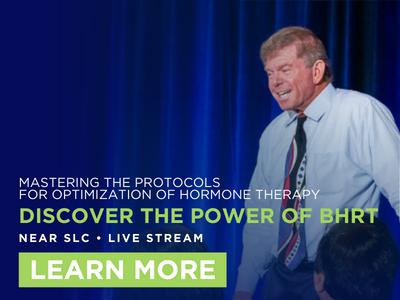
PCSK-9 Inhibitors : Another Therapeutic Illusion
Written by Neal Rouzier, MD

If you are interested in learning more about the value and efficacy of Bioidentical hormones in HRT as an alternative to medication-based therapies, please consider our four part hormone optimization workshop series.
Table of Contents
Introduction
Recently, a new cholesterol lowering drug was approved in the U.K. The press-release heralded Inclisiran, simply another PCSK-9 inhibitor, to be a game changer as it will save thousands of lives by lowering cholesterol. No, there are no outcome studies yet, only studies that demonstrate it lowers serum cholesterol 50% more than statins alone. The authors assume and extrapolate that lowering LDL cholesterol with this drug will result in thousands of lives saved. That is termed therapeutic illusion. However, multiple studies in the U.K. have demonstrated that other PCSK-9 inhibitors, evolocumab and alirocumab, did not save lives wherein several studies demonstrated an increase in mortality. In the U.S., PCSK-9 inhibitors have demonstrated a 1% ARR in CVD events with no change in mortality. And we will ignore the negative studies in favor of the positive studies that did show benefit, right? Also, Inclisiran need be given only twice per year at a cost of $10,000/shot. This is in contrast to other PCSK-9 inhibitors given monthly at a cost of $5,000/month, although costs have decreased. These drugs do a marvelous job of decreasing cholesterol levels, but no study overwhelmingly demonstrates a decrease in plaque or events or mortality. The authors assume that by lowering the cholesterol level another 50% that will translate into improved CVD outcomes. Don’t assume and don’t extrapolate, but we are misled to believe in the hype.
The Glucose-Centric Model
A recent paper in JAMA 2020;323(12):1184-1185, reviewed intermediate outcomes vs surrogate outcomes. To reduce the cost of trial resources, a frequent approach has been to use a biomarker or another replacement endpoint that is an intermediate outcome (cholesterol level) thought to capture the causal pathway through which the disease process affects patient-centered outcomes (CVD). Intermediate outcomes, which may be laboratory test results (LDL) or imaging results, are appealing because trials that use these surrogate markers are shorter and smaller than those that evaluate patient centered outcomes like MI or mortality. But they are not patient outcome studies.
Despite the appeal of using intermediate endpoints (like cholesterol levels), several fundamental requirements must be met to ensure that the replacement endpoint (cholesterol level) is a valid surrogate, i.e., the effect of the intervention on the replacement end point reliably predicts its effect on the patient-centered outcome (decrease in plaque, MI, or mortality). The first requirement is that the replacement endpoint (cholesterol level) and the patient-centered outcome (decrease in plaque, CVD events, mortality) are strongly correlated. As I reviewed in the first newsletter, the long-term studies utilizing diabetes meds that lowered the HgBA1C the most were predictive of increased CVD and mortality, different from what we would expect. So, lowering the HgBA1C the most resulted in worse CVD outcomes, not better (JAMA & NEJM). Thus, a correlate does not a surrogate make. Even though high levels of HgBA1C portend worse DM and CVD outcomes, lowering the surrogate marker HgBA1C does not result in less CVD events or mortality outcomes. Similarly, lowering the cholesterol the most would be assumed to decrease CVD events and mortality. However, recent studies of PCSK-9 inhibitors do not result in better patient-centered outcomes even though logically it would make perfect sense. Again, a correlate does not a surrogate make. Improving the surrogate number (cholesterol) does not necessarily correlate with improved patient outcomes. Don’t assume or extrapolate.
JAMA 2021;326(3):217-218. A meta-analysis of 39 RCTs (60,328 patients) showed that PCSK-9 inhibitors added to maximally tolerated statins were associated with reduced ischemic stroke (ARR 1.1%) and a number needed to treat (NNTT) = 305. Hmmm. A meta-analysis of 7 RCTs of patients with diabetes at high CVD risk found that GLP-1 RAs were associated with a reduced rate of stroke (ARR 2.6%) and NNTT = 250. Hmmm, again. At least those are patient-centered outcomes., but the results are still underwhelming.
Under the best circumstances, we use tests and treatments under the illusion that we are doing better than we actually are. This is termed therapeutic illusion and affects all of us. This implicit bias overestimates the benefits and underestimates the harm of what we do. Many studies before and after a positive article are almost always negative. Astonishingly, the small positive study gets elevated to become the standard of care. Meanwhile, all the negative studies, even those much larger and better conducted, are simply ignored. In addition, we tend to assume and extrapolate benefits where science has not proven benefit. This is called indication creep. If statins are so beneficial for secondary CVD prevention, then they must also be beneficial for primary prevention, even if CAC scores are zero. We tend to believe what we want to believe and reject what does not fit our agenda or beliefs. This issue I will address in greater detail in Beyond Hormones utilizing EBM that we don’t know but should. “Here, read this!”
None of us are immune from implicit bias. I am extremely biased, but that bias comes from overwhelming EBM. In the words of Leo Tolstoy: “I know that most men, including those at ease with problems of the greatest complexity, can very seldom discern even the simplest and most obvious truth if it be such as to oblige them to admit the falsity of their conclusions they have formed, perhaps with much difficulty-conclusions of which they are proud, which they have taught others and on which they have built their lives and careers, but are wrong.” Even if we embrace all the scientific evidence as fairly as we can, and these studies are done under the very best circumstances, there still may be bias. And there may be many negative studies that are never published as it is only in the best interest of pharmaceutical companies to squelch negative outcomes. Benefits and harms should be divulged to doctors as well as patients. The downstream harm must be subtracted from the small percentage of benefit. Do the benefits truly outweigh the risks? We are frequently convinced of this as in the case of statin medication. Therapeutic illusion has exploded under the guise of clinical protocols, guidelines, and expert recommendations to convince us that we should/must prescribe these medications. I’m so tired/frustrated of reading/hearing that “the benefits outweigh the risks.” Well, no they don’t! And I will use a plethora of EBM literature to prove them wrong. So many of the drugs/treatments make us worse due to harm, but the “opinions” of paid experts to make those claims that benefits outweigh the risks are simply biased on their claims and opinions that are not supported by the evidence. Of course, I will present all the data and literature as to how that harm can be avoided but is simply ignored.
The bottom line is that truth is complex and difficult to come by. Science is a controlled attempt at approximating truth. Good science attempts to minimize bias. We commonly trust the experts or medical academy protocols more than the total weight of scientific evidence, much of which is negative, and we will never know that. Pharmaceutical company and researcher bias, combined with therapeutic illusion and personal beliefs, overestimate benefit and underestimate harms and risk. And what about that NNTT of 300? I am so tired of hearing that the benefits outweigh the risks. Well, no they don’t and that’s what I plan to address at this year’s Beyond Hormones Symposia. That’s my therapeutic nihilism-skepticism regarding the worth of therapeutic agents. In medicine, it was connected to the idea that many “cures” do more harm than good. “Here, read this.”
Conclusion
My goal/point is: 1) Benefits don’t outweigh the risks and the literature proves this. However, biased pharmaceutical studies can easily make the benefit significantly outweigh any risk and that’s what paid experts do when they publish studies. 2) There are so many ways to avoid and negate any risk or harm. That’s what drives my passion. And it’s all EBM. Yet expert opinions and medical society guidelines ignore literature of how to avoid the risks. 3) Scientific literature/knowledge that reverses/prevents any harm of commonly prescribed medications is ignored by most physicians and medical academies (due to their cognitive dissonance and confirmation bias). And that really irks me but also drives my passion. 4) We can’t discern the forest for the trees. Does no one see the elephant in the room? Is it just me that sees the elephant? Why do we ignore all the studies and literature? Simply because there is no pharmaceutical company marketing behind it? 5) I am amazed at my sub-specialty colleagues that just don’t get it and reject their own literature. “If it was so good, then everyone would be doing it.” My response to that is: “The only ones that don’t do it are the ones that don’t know, read, understand, or that are not up to date on their most recent scientific literature.” You could hear a pin drop. I’ve got some great stories to share. I’ll look forward to sharing these stories at the upcoming Beyond Hormones Conference in Austin, Texas. See you then.
P.S. If you would like to look at outcome studies that demonstrate plaque reversal and a decrease in CVD as well as improvement in IR and CVD risk factors, please see the attached articles demonstrating the effects of thyroid administration. Do you know of any cardiologists or endocrinologists that recommend thyroid optimization to reverse plaque and CVD?
